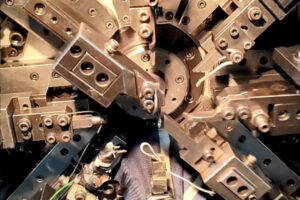Helical Tension and Torsion Springs Manufacturing
Introduction
 Helical tension and torsion springs are critical components in mechanical systems, providing essential functions such as load absorption, motion control, and energy storage. The manufacturing processes for these springs vary depending on production scale, precision requirements, and material properties. China Custom Spring, a professional custom-made spring and wire forming manufacturer in China, employs both semi-mechanical/handcrafted methods and advanced CNC spring forming machines to produce high-quality springs for industries such as automotive, aerospace, and electronics.
Helical tension and torsion springs are critical components in mechanical systems, providing essential functions such as load absorption, motion control, and energy storage. The manufacturing processes for these springs vary depending on production scale, precision requirements, and material properties. China Custom Spring, a professional custom-made spring and wire forming manufacturer in China, employs both semi-mechanical/handcrafted methods and advanced CNC spring forming machines to produce high-quality springs for industries such as automotive, aerospace, and electronics.
This article explores the key manufacturing techniques for helical tension and torsion springs, comparing traditional and modern approaches, and analyzing their advantages, limitations, and applications.
1. Semi-Mechanical & Handcrafted Manufacturing
1.1 Helical Tension Springs
Process Overview
The production of helical tension springs closely resembles that of compression springs, with the primary difference lying in the forming of end hooks or loops. The typical process includes:
-
Coiling:
-
Traditional method: Using a mandrel-based coiling machine (vertical or horizontal).
-
Alternative: Straight-tail coiling machines (vertical mandrel type) for improved precision.
-
-
Stress Relief Annealing:
-
Performed after coiling to eliminate internal stresses.
-
Temperature control: 200–300°C (varies by material).
-
-
Hook/Loop Formation:
-
Small springs: Hand-formed using pliers or specialized tools.
-
Standard springs: Bent using manual/automated hook-forming tools or dies.
-
Long-hook designs: Extra material is left during coiling, straightened, and then bent into shape.
-
Key Considerations
-
Multiple annealing stages:
-
After coiling.
-
After hook formation (at 20–30°C lower temperature to prevent hook distortion).
-
-
No shot peening or strong pulling: Unlike compression springs, tension springs typically skip these steps to avoid deformation.
1.2 Helical Torsion Springs
Process Overview
Torsion springs share similarities with tension/compression springs but require specialized end-arm processing:
-
Coiling:
-
Low-volume production: Manual/semi-automatic mandrel coiling.
-
High-volume production: CNC straight-tail or torsion-specific machines.
-
-
Arm Bending:
-
Complex arms may require secondary tooling/fixtures.
-
-
Stress Relief Annealing:
-
Conducted twice (after coiling and arm forming).
-
Design & Manufacturing Challenges
-
Close-wound springs:
-
Generate frictional hysteresis during loading/unloading.
-
Solution: Introduce small gaps between coils to reduce friction.
-
-
Arm formation:
-
Must be completed in one bend to avoid defects.
-
2. CNC Spring Forming Machines (Advanced Automation)
2.1 Evolution of CNC Spring Formers
Modern CNC machines enable single-step forming of complex springs by combining four basic geometries: circles, arcs, angles, and straight lines.
Machine Configurations
-
2-Axis Machines:
-
X-axis (forming): Uses 8 cam-driven sliders for bending/cutting.
-
Y-axis (wire feed): Controls material input.
-
Limitation: Fixed mandrels require frequent reshaping for different springs.
-
-
3-Axis Machines:
-
Adds R-axis (rotation): Mandrel can rotate (0.09° precision), reducing setup time.
-
-
Multi-Axis (Up to 13-Axis):
-
S-axis (curling): Enables 3D complex shapes.
-
Camless designs: Each slider is independently servo-driven, allowing programmable adjustments.
-
Breakthrough: Rotating-Wire Technology
-
Traditional machines cannot form multi-plane bends.
-
Rotating-wire CNC machines:
-
Incorporate a 360° wire-rotating servo motor.
-
Enable 3D spatial bending with a single tool.
-
2.2 Comparison of CNC Machine Types
| Feature | 2-Axis Cam-Driven | 3-Axis Rotating Mandrel | Multi-Axis Camless | Rotating-Wire CNC |
|---|---|---|---|---|
| Wire Feed | Single motor | Single motor | Independent servo | Independent servo |
| Forming Control | Cam-limited | Improved flexibility | Full CNC programmability | 3D bending capability |
| Setup Time | High (manual cam adjustment) | Moderate | Low (digital tuning) | Very low |
| Applications | Simple springs | Medium-complexity springs | High-precision springs | Aerospace/medical |
3. Industry Applications by China Custom Spring
As a leading spring manufacturer in China, China Custom Spring leverages these technologies for:
-
Automotive: Clutch springs (torsion), seatbelt retractors (tension).
-
Electronics: Battery contacts (miniature tension springs).
-
Medical Devices: Surgical tool springs (high-precision CNC-formed).
Case Study:
-
A high-volume torsion spring for electric vehicles was optimized using camless CNC machines, reducing production time by 40% while maintaining ±0.1mm tolerance.
4. Future Trends
-
AI-Driven Spring Design: Machine learning for predictive tool wear and bend optimization.
-
Hybrid Manufacturing: Combining additive manufacturing (3D printing) with CNC forming for custom geometries.
Conclusion
The manufacturing of helical tension and torsion springs has evolved from labor-intensive methods to highly automated CNC processes. China Custom Spring exemplifies this progress, delivering precision springs through advanced camless and rotating-wire CNC machines. Future advancements will further enhance efficiency, particularly in multi-axis automation and smart manufacturing.






